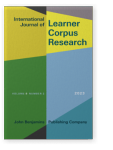Vol. 9:2 (2023) ► pp.180–214
L1 novice writing as a missing piece in the Learner Corpus Research puzzle
The case of hedging
This paper investigates the possible benefits of integrating an L1 novice corpus into the study of learner writing, through a study on hedging adverbials and complement clauses. A more traditional tripartite comparison is first drawn between French EFL learner writing, L1 English novice writing, and English expert writing. Then, a comparison is made between L1 French novice writing and French EFL learner writing. The study uses data from the following corpora: the Varieties of English for Specific Purposes dAtabase (VESPA; Paquot et al., 2022) (French EFL learner writing), the British Academic Written English (BAWE; Heuboeck et al., 2008) corpus and the Michigan Corpus of Upper-level Student Papers (MICUSP; Ädel & Römer, 2012) (both L1 English novice writing), the Kulturell Identitet i Akademisk Prosa: nasjonal versus disiplinavhengig (KIAP‑EN; Fløttum et al., 2006) corpus (English expert writing), and the The French Academic wRiting (FAR) corpus (L1 French novice writing). The results speak to the importance of including a L1 novice component to the current methodologies employed in Learner Corpus Research (LCR), since such inclusion helps to provide a better and more nuanced interpretation of the findings obtained by means of a more traditional tripartite approach.
Article outline
- 1.Introduction
- 2.Methodology
- 2.1Corpus data
- 2.1.1French EFL learner writing
- 2.1.2L1 English novice writing
- 2.1.3English expert writing
- 2.1.4L1 French novice writing
- 2.1.5Comparability of the corpora
- 2.2Operationalization of hedging
- 2.3Hedge identification
- 2.3.1Adverbials
- 2.3.2Complement clauses
- 2.4Data disambiguation
- 2.5Statistical methods
- 2.1Corpus data
- 3.Results
- 3.1Frequencies
- 3.2Lexical preferences
- 3.3Diversity of hedge use
- 4.Discussion
- 5.Conclusion
- Notes
-
References
